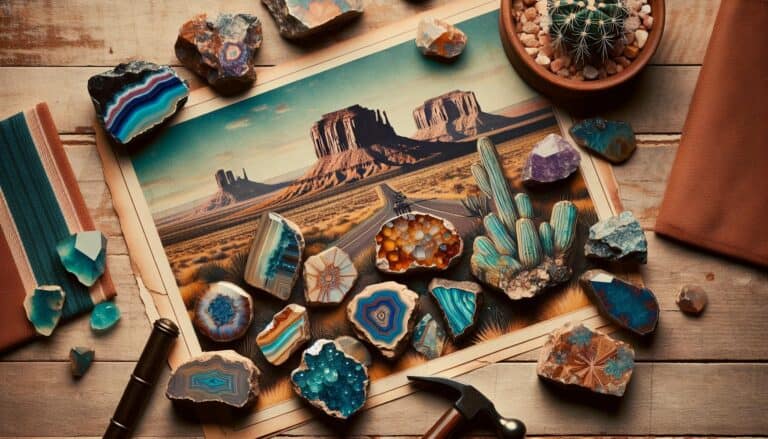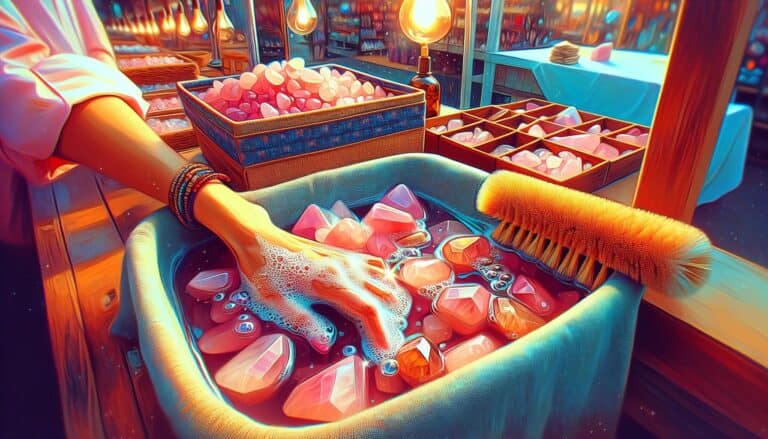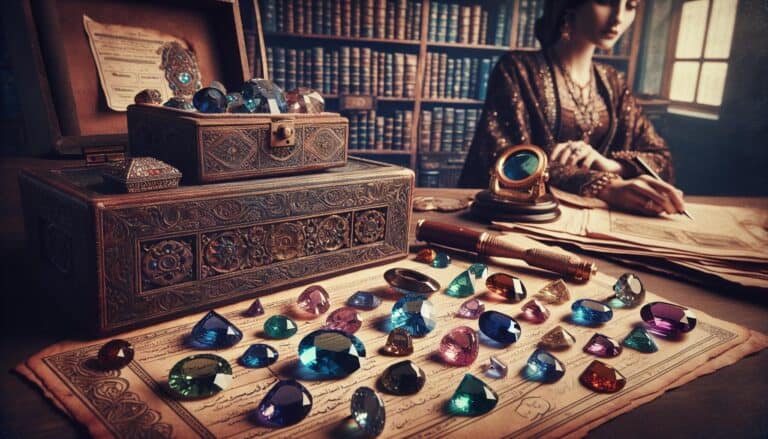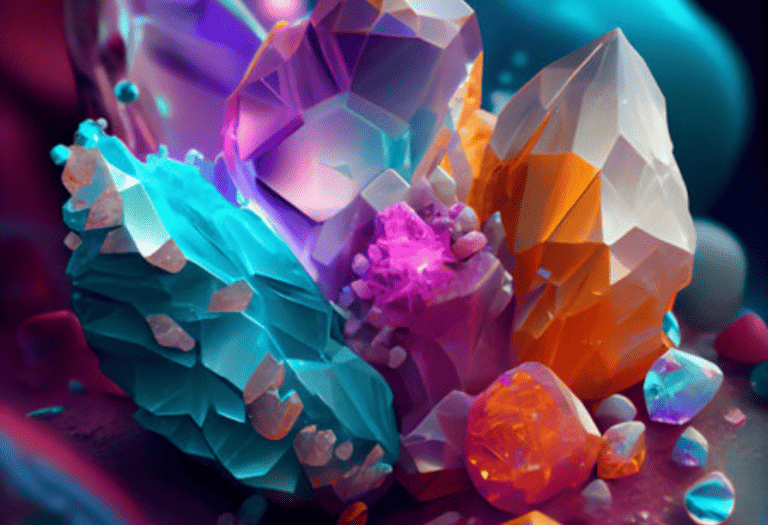Discovering the allure of benitoite, California’s state gemstone, is like uncovering a hidden treasure.
Known for its striking blue hue, this rare gem can be a collector’s dream. But how do you know if you’ve truly found benitoite?
Identifying this precious stone is key, and you’re in luck because it’s not as daunting as it seems. With the right know-how, you’ll be spotting benitoite like a pro in no time. Let’s dive into the characteristics that make benitoite stand out from the rest.
From its unique color to its distinctive crystal formation, understanding what sets benitoite apart is essential.
Get ready to learn the insider tips that’ll help you identify a genuine benitoite gemstone with confidence.
Identifying benitoite involves checking for its vivid sapphire blue hue and unique triangular crystal structure. Perform a streak test, as genuine benitoite leaves a light blue streak. Also, test for hardness (6-6.5 Mohs scale), birefringence under a polariscope, and refractive index (1.757-1.804).
How to Identify benitoite Through Testing
Visual Inspection
Start by examining the gemstone’s color. Authentic benitoite has a vivid sapphire blue hue, although it can also appear colorless or in shades of pink and green. Look closely for a unique, triangular growth pattern, a telltale sign of benitoite’s crystal structure. It’s also beneficial to check for the stone’s transparency and high luster, which can be indicative of its authenticity.
The Streak Test
Conduct the streak test by rubbing your benitoite against a piece of unglazed porcelain tile. Benitoite will leave a colorless or very light blue streak. If the streak appears to be a different color, it could indicate that the stone isn’t genuine benitoite.
Magnet Test
While benitoite isn’t magnetic, performing a magnet test can help rule out other minerals. Pass a strong magnet over the stone. A lack of magnetic attraction supports the possibility that you’re handling benitoite, though further tests would be required for confirmation.
Hardness Test
Benitoite falls between 6 and 6.5 on the Mohs hardness scale. To test this, try scratching your stone with a piece of quartz (hardness 7). If the quartz scratches it, the stone is softer than benitoite. Conversely, if your stone is unmarked, it may well be benitoite.
Birefringence Test
Place the benitoite gemstone under a polariscope to check for birefringence, which is the splitting of a light ray into two paths. Benitoite should display a moderate to strong birefringence due to its dichroic nature, presenting two different colors when observed from various angles.
Checking The Diaphaneity
Diaphaneity refers to a gemstone’s ability to transmit light, ranging from transparent to opaque. Genuine benitoite typically presents as transparent to translucent. If your specimen allows light to pass through, it’s a point in favor of its authenticity.
Single or Double Refraction
Benitoite is a double-refractive material – it refracts two light rays, producing a double image of objects viewed through the gemstone. When you view a line or a point through the stone, it should appear as two lines or points if the gemstone is benitoite.
Refractive Index Test
Performing a refractive index test can help confirm if you have benitoite. Its refractive index generally falls within the range of 1.757 to 1.804. Specialized equipment like a refractometer is required for this test, which can provide a precise reading.
Finding The Specific Gravity
The specific gravity of benitoite falls between 3.65 and 3.68. You can measure this at home using a hydrostatic balance or at a professional lab. This test is critical as specific gravity is a distinctive property that can help distinguish benitoite from other minerals with similar characteristics.
Identifying Benitoites in the Field
Out in the field, search primarily within the serpentine group of rocks, where benitoite is often found. Look for stones with the signature blue hue and triangular shapes characteristic of benitoite crystals. Geologically, regions with a history of hydrothermal activity are your best bet.
Recognizing Potential Benitoite Rocks
When surveying an area, know that benitoite often resides within or alongside natrolite, a white to colorless mineral. Observing rocks with visible blue crystals embedded in natrolite can be a strong indicator of the presence of benitoite. Use your instinct and knowledge to pick out rocks that could potentially contain this rare and beautiful gemstone.
Physical Characteristics of benitoites

When embarking on the journey to identify benitoite, knowing its physical characteristics is crucial. Benitoite typically presents in sapphire blue to violet shades, yet you may find variations ranging from colorless to light blue. It’s the distinct color that often first catches the eye.
Pay close attention to the crystal structure of benitoite. This gemstone forms in a unique hexagonal pattern, which can be a telling sign you’ve found a genuine specimen. Moreover, the crystals are usually tabular or flat and can become quite large in size. You’ll notice that benitoite has a high dispersion, which means it displays a remarkable fire—similar to a diamond’s sparkle when exposed to light.
Here’s something that sets benitoite apart: it’s variably fluorescent under UV light. In simpler terms, it glows! When you place it under a UV light, it can show an impressive blue to chalky blue fluorescence.
Lastly, the gemstone’s hardness falls around 6 to 6.5 on the Mohs scale. While durable, it’s not as hard as some other popular gemstones like sapphires or diamonds, so you’ll want to handle benitoite with care to avoid scratches or damage.
Take a moment to scrutinize your benitoite’s transparency and luster. A genuine stone should exhibit good transparency along with a submetallic to vitreous luster, further enhancing its overall appeal and confirming its identity.
How Are benitoite Formed?
When you’re seeking to understand benitoite’s identity, it helps to know how this rare gemstone comes into being. Benitoite is formed in low- to high-temperature hydrothermal systems – environments where mineral-rich water circulates through rock fractures. Serpentine rocks, a key environment for benitoite formation, play a significant role as the host rock. In the depths where pressure and temperature conditions are just right, the elemental soup comprising barium, titanium, and silicon crystallizes to form this exquisite gem.
Unique to its kind, benitoite’s triangular crystals are a direct result of its tetragonal crystal system, a fact indicative of the precise natural conditions under which it forms. Most benitoite crystals grow in small cavities within serpentine, where they have the space to develop their noteworthy crystal habit. The process is not quick; it takes thousands, if not millions of years for benitoite crystals to form and reach the size that gets a gem enthusiast’s heart racing.
Subsequent alteration of the host rock and erosion can lead to benitoite being released from its original location. If you’re in the right locale, such as certain areas within California, you might find benitoite embedded in Natrolite, a secondary mineral which often serves as a cue to the presence of this rare blue gemstone.
Understanding benitoite’s genesis sheds light on the conditions that create its remarkable characteristics. This knowledge serves as a springboard to advance into the realm of practical benitoite identification and hunting, combining geological insight with the hands-on testing methods previously described.
Preparation for benitoite Hunting
When setting out to hunt for benitoite, being well-prepared not only increases your chances of success but also ensures your safety and efficiency during the process.
Gathering the Right Tools
Before you embark on your benitoite hunting expedition, it’s crucial to equip yourself with the right tools. Here’s a list of essentials you’ll need:
- Geologist’s hammer: To break and chisel through rocks.
- Chisel and pry bar: For extracting specimens from the host rock.
- Safety glasses: To protect your eyes from flying rock fragments.
- Hand lens or magnifier: For close inspection of potential finds.
- UV light: Benitoite is known for its fluorescence; a UV light can help identify specimens in the field.
- Field guide and maps: Having detailed geological maps and a field guide specific to the area can lead you to the most fruitful locations.
- Buckets and bags: To carry your finds.
Remember that these tools not only help in finding benitoite but also in the initial on-site validation of potential specimens. A good practice is to label your tools and keep an inventory to track them during your hunt.
Safety Considerations
Your safety should always be your top priority. Here’s how to keep safe while searching for benitoite:
- Wear appropriate attire: Durable boots, gloves, and protective clothing will safeguard you against sharp rocks and rough terrain.
- Stay hydrated: Bring plenty of water, especially if you’re hunting in areas with a warm climate.
- Inform someone of your plans: Always let someone know where you’re heading and when you expect to return.
- First aid kit: Keep a well-stocked first aid kit handy for any minor injuries.
- Be wary of wildlife: Understand the fauna of the region and how to react if you encounter wildlife.
Considering these safety measures will help to prevent accidents and ensure that your benitoite hunting is a positive experience. By preparing effectively, you’re setting yourself up for a successful hunting trip with the potential to uncover this stunning gemstone.
Handling and Care of Found benitoites

After you’ve successfully unearthed a benitoite gemstone, it’s crucial to handle it with the care and respect it deserves. As a rare and delicate gem, benitoite requires specific attention to maintaining its brilliance and value. Here’s how you can clean and store your found benitoites properly.
Cleaning benitoites
Cleaning your newly found benitoite is an important step to preserve its natural beauty. Here’s how you can safely clean the stone:
- Use a Soft Brush: Gently sweep off any loose dirt or debris with a soft-bristled brush to avoid scratching the surface.
- Mild Soap Solution: Prepare a warm, soapy solution using a mild detergent, which is gentle enough not to damage the gemstone.
- Rinsing: Carefully rinse the benitoite under lukewarm running water to remove any soap residue. Make sure the water isn’t too hot or too cold, as extreme temperatures can cause damage.
- Pat Dry: After rinsing, pat the gemstone dry with a soft, lint-free cloth. Air drying can leave water spots, so it’s best to avoid it.
Storing benitoites
Storing your benitoite is as important as cleaning it. Proper storage ensures the safety and longevity of your gemstone. Here are some tips for storage:
- Individual Containers: Keep each benitoite in a separate container to prevent them from scratching each other. A soft pouch or a fabric-lined jewelry box works well.
- Away from Other Gems: Store benitoite away from harder stones that might scratch its surface.
- Cool, Dry Place: Find a controlled environment free from temperature fluctuations and humidity, as these can cause the gem to deteriorate over time.
Remember, taking the time to handle your benitoites correctly will help maintain their luster and value for years to come. Consider periodic checks on your stored stones to ensure they remain in top condition.
Conclusion: Confirming Benitoite Real
Armed with the knowledge of benitoite’s unique characteristics and formation process you’re well on your way to confirming your find.
Remember the importance of the right tools and safety measures when hunting for this rare gemstone. Once you’ve found a potential specimen handling and care are crucial to preserve its beauty and value.
Trust in your newfound understanding to identify benitoite with confidence and cherish the thrill of discovering one of nature’s treasures.







